Generac 04758-1, 04759-1, 04760-1 User Manual

Installation and
Owner’s Manual
Air-cooled Automatic Standby Generators
Models:
04758-1 (6 kW NG, 7 kW LP)
04759-1 (12 kW NG, 12 kW LP)
04760-1 (13 kW NG, 15 kW LP)
GENERAC R
POWER SYSTEMS, INC.
R
! |
Not intended for use as Primary Power in place of utility |
! |
|
or in life-support applications. |
|||
|
|

 DANGER
DANGER
DEADLY EXHAUST FUMES. OUTDOOR INSTALLATION ONLY!!

INTRODUCTION
Thank you for purchasing this model by Generac Power Systems Inc.. This model is a compact, high performance, air-cooled, engine-driven generator designed to automatically supply electrical power to operate critical loads during a utility power failure.
This unit is factory installed in an all-weather, metal enclosure that is intended exclusively for outdoor installation. This generator will operate using either vapor withdrawn liquid propane (LP) or natural gas (NG).
This unit meets the 1998 and later California emissions regulations. To ensure that the engine continues to meet these regulations, refer to the following information and instructions in this owner’s manual.
ENGINE EMISSION COMPLIANCE PERIOD
For nonhandheld engines: The Emissions Compliance Period referred to on the Emissions Compliance label indicates the number of operating hours for which the engine has been shown to meet federal emission requirements.
For engines less than 225 cc displacement, Category C = 125 hours, B = 250 hours, and A = 500 hours.
For engines 225 cc or more, Category C = 250 hours, B = 500 hours, and A = 1000 hours.
READ THIS MANUAL THOROUGHLY
If any portion of this manual is not understood, contact the nearest Generac Authorized Dealer for starting, operating and servicing procedures.
Throughout this publication, and on tags and decals affixed to the generator, DANGER, WARNING, CAUTION and NOTE blocks are used to alert personnel to special instructions about a particular operation that may be hazardous if performed incorrectly or carelessly. Observe them carefully. Their definitions are as follows:

 DANGER
DANGER
After this heading, read instructions that, if not strictly complied with, will result in serious personal injury, including death, in addition to property damage.
After this heading, read instructions that, if not strictly complied with, may result in serious personal injury or property damage.
After this heading, read instructions that, if not strictly complied with, could result in damage to equipment and/or property.
NOTE:
After this heading, read explanatory statements that require special emphasis.
These safety warnings cannot eliminate the hazards that they indicate. Common sense and strict compliance with the special instructions while performing the service are essential to preventing accidents.
Four commonly used safety symbols accompany the DANGER, WARNING and CAUTION blocks. The type of information each indicates follows:
This symbol points out important safety informa- ! tion that, if not followed, could endanger personal
safety and/or property of others.
This symbol points out potential explosion hazard. |
 This symbol points out potential fire hazard.
This symbol points out potential fire hazard.
This symbol points out potential electrical shock hazard.
The operator is responsible for proper and safe use of the equipment. We strongly recommend that the operator read this Owner's Manual and thoroughly understand all instructions before using this equipment. We also strongly recommend instructing other users to properly start and operate the unit. This prepares them if they need to operate the equipment in an emergency.
CONTENTS
This manual contains pertinent owner’s information, including warranty, electrical diagrams, exploded views and lists of repair parts, for three different Guardian models:
•04758-1 – 6 kW NG, 7 kW LP, single-cylinder GH410 Engine
•04759-1 – 12 kW NG, 12 kW LP, V-twin GT-990 Engine
•04760-1 – 13 kW NG, 15 kW LP, V-twin GT-990 Engine
OPERATION AND MAINTENANCE
It is the operator's responsibility to perform all safety checks, to make sure that all maintenance for safe operation is performed promptly, and to have the equipment checked periodically by a Generac Authorized Dealer. Normal maintenance service and replacement of parts are the responsibility of the owner/operator and, as such, are not considered defects in materials or workmanship within the terms of the warranty. Individual operating habits and usage contribute to the need for maintenance service.
Proper maintenance and care of the generator ensures a minimum number of problems and keep operating expenses at a minimum. See the Generac Authorized Dealer for service aids and accessories.
HOW TO OBTAIN SERVICE
When the generator requires servicing or repairs, simply contact a Generac Authorized Dealer for assistance. Service technicians are factory-trained and are capable of handling all service needs.
When contacting a Generac Authorized Dealer or the factory about parts and service, always supply the complete model number and serial number of the unit as given on its data decal, which is located on the generator. See Figure 1.1 or Figure 1.2 in Section 1.4 for decal location.
Model No. ____________ Serial No. ______________
AUTHORIZED DEALER LOCATION
To locate the GENERAC AUTHORIZED DEALER nearest you, please call this number:
1-800-333-1322
DEALER LOCATION INFORMATION CAN BE OBTAINED AT THIS NUMBER.

Table of Contents
Guardian Air-cooled 7 kW, 12 kW and 15 kW Generators
Introduction ........................ |
Inside Front Cover |
|
Read This Manual Thoroughly ........................ |
IFC |
|
Contents .......................................................... |
|
IFC |
Operation and Maintenance |
............................ |
IFC |
How to Obtain Service .................................... |
|
IFC |
Authorized Dealer Locator Number .................... |
IFC |
|
Safety Rules ........................................................ |
2 |
||
Standards Index .................................................. |
3 |
||
Section 1 – General Information .................. |
4 |
||
1.1 |
Unpacking/Inspection .................................... |
4 |
|
1.2 |
Protection Systems ........................................ |
4 |
|
1.3 |
System Set LED ............................................ |
4 |
|
1.4 |
The Generator .............................................. |
5 |
|
1.5 |
Specifications ................................................ |
6 |
|
|
1.5.1 |
Generator .......................................... |
6 |
|
1.5.2 |
Engine ................................................ |
6 |
1.6 |
Fuel Requirements and Recommendations.... |
7 |
|
1.7 |
Fuel Consumption ........................................ |
7 |
|
1.8 |
Reconfiguring the Fuel System ...................... |
7 |
|
|
1.8.1 |
7 kW, 410CC ...................................... |
7 |
|
1.8.2 12 kW and 15 kW, 990cc Engines ...... |
7 |
|
1.9 |
Location ........................................................ |
8 |
|
|
1.9.1 |
Generator .......................................... |
8 |
|
1.9.2 |
Transfer Switch .................................. |
8 |
1.10 |
Battery Installation ........................................ |
9 |
|
1.11 |
The Battery.................................................... |
9 |
|
Section 2 – Post Installation Start-up |
|
||
|
|
and Adjustments ...................... |
10 |
2.1 |
Before Initial Start-up .................................. |
10 |
|
2.2 |
Check Transfer Switch Operation................ |
10 |
|
2.3 |
Electrical Checks ........................................ |
10 |
|
2.4 |
Generator Tests Under Load ...................... |
11 |
|
2.5 |
Checking Automatic Operation .................... |
11 |
|
2.6Adjusting the Regulator (Natural Gas Only) ..12
2.7 |
Engine Governor Adjustment ...................... |
12 |
|
|
2.7.1 |
7 kW Units ...................................... |
12 |
|
2.7.2 12 kW and 15 kW Units .................. |
13 |
|
|
2.7.3 |
Additional Corrosion Protection ...... |
13 |
2.8 |
Voltage Regulator Adjustment...................... |
13 |
|
Section 3 – Operation .................................... |
13 |
||
3.1 |
Break-in Procedure...................................... |
13 |
|
3.2 |
Using the Auto/Off/Manual Switch .............. |
14 |
|
|
3.2.1 |
“Auto” Position .................................. |
14 |
|
3.2.2 |
“Off” Position.................................... |
14 |
|
3.2.3 |
“Manual” Position ............................ |
14 |
3.3 |
Automatic Transfer Operation .................... |
14 |
|
3.4 |
Sequence of Automatic Operation................ |
14 |
|
3.5 |
Manual Transfer Operation ........................ |
15 |
|
|
3.5.1 |
Transfer to Generator |
|
|
|
Power Source...................................... |
15 |
|
3.5.2 Transfer Back to Utility |
|
|
|
|
Power Source...................................... |
15 |
3.6 |
Setting the Exercise Timer .......................... |
16 |
|
3.7 |
Protection Systems ...................................... |
16 |
|
|
3.7.1 Low Oil Pressure Switch .................. |
16 |
|
|
3.7.2 |
High Temperature Switch ................ |
16 |
|
3.7.3 |
Overcrank ........................................ |
16 |
|
3.7.4 |
Overspeed ........................................ |
16 |
Section 4 – Maintenance .............................. |
17 |
||
4.1 |
Fuse |
............................................................ |
17 |
4.2 |
Checking ....................the Engine Oil Level |
17 |
|
4.3 |
Changing ..............................the Engine Oil |
17 |
|
|
4.3.1 .......... |
Engine Oil Recommendations |
17 |
|
4.3.2 ...................... |
Oil Change Procedure |
18 |
4.4 |
Changing ................................the Oil Filter |
18 |
|
4.5 |
Changing ................the Engine Air Cleaner |
18 |
|
|
4.5.1 7 kW, 12 kW and 15 kW |
|
|
|
........................................ |
Generators |
18 |
4.6 |
Spark ..............................................Plug(s) |
19 |
|
4.7 |
Battery ....................................Maintenance |
19 |
|
4.8 |
Adjusting ............................Valve Clearance |
20 |
|
4.9 |
Cooling ............................................System |
20 |
|
4.10 |
Attention ........................After Submersion |
21 |
|
4.11 |
Corrosion ..................................Protection |
21 |
|
4.12 |
Out of ............................Service Procedure |
21 |
|
|
4.12.1 ......................Removal From Service |
21 |
|
|
4.12.2 ..............................Return to Service |
21 |
|
4.13 |
Service ........................................Schedule |
22 |
|
Section 5 ........................– Troubleshooting |
23 |
||
5.1 |
Troubleshooting ................................Guide |
23 |
|
Section 6 ............................– Electrical Data |
24 |
||
Section 7 – Exploded Views and |
|
||
|
.................................... |
Parts Lists |
32 |
Section 8 ..............– Mounting Dimensions |
50 |
||
Section 9 ............................................– Notes |
51 |
||
Section 10 ....................................– Warranty |
52 |
||
|
|
|
1 |
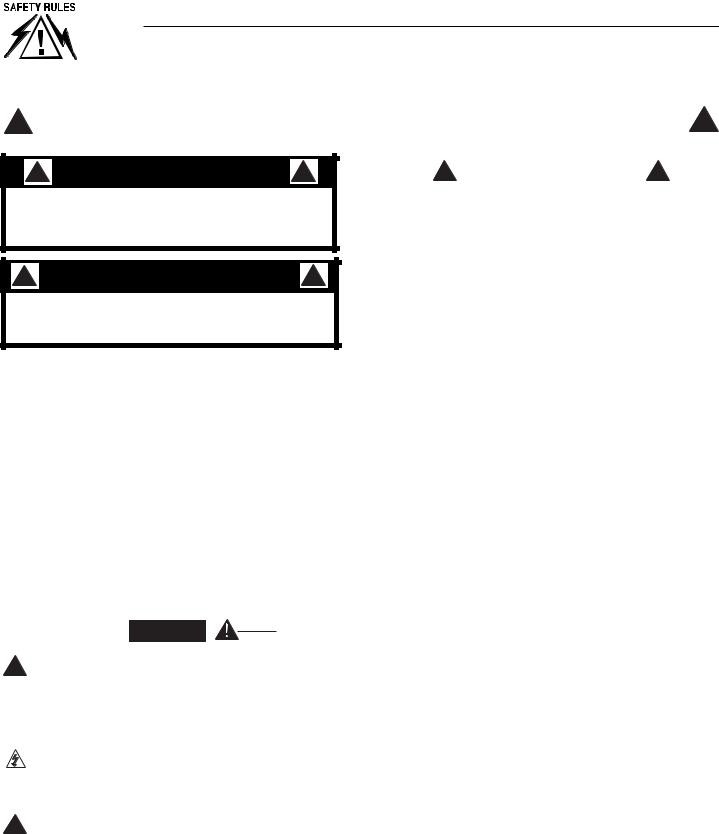
IMPORTANT SAFETY INSTRUCTIONS
Guardian Air-cooled 7 kW, 12 kW and 15 kW Generators
|
SAVE THESE INSTRUCTIONS – The manufacturer suggests that these rules for safe |
|
! |
operation be copied and posted near the unit’s installation site. Safety should be stressed to |
! |
|
all operators and potential operators of this equipment. |
|
!WARNING: !
The engine exhaust from this product contains chemicals known to the state
of California to cause cancer, birth defects or other reproductive harm.
! |
WARNING: |
! |
|
|
|
|
This product contains or emits chemicals |
|
|
known to the state of California to cause |
|
cancer, birth defects or other reproductive harm. |
||
Study these SAFETY RULES carefully before installing, operating or servicing this equipment. Become familiar with this Owner’s Manual and with the unit. The generator can operate safely, efficiently and reliably only if it is properly installed, operated and maintained. Many accidents are caused by failing to follow simple and fundamental rules or precautions.
Generac cannot possibly anticipate every possible circumstance that might involve a hazard. The warnings in this manual, and on tags and decals affixed to the unit are, therefore, not all-inclusive. If using a procedure, work method or operating technique Generac does not specifically recommend, ensure that it is safe for others. Also make sure the procedure, work method or operating technique chosen does not render the generator unsafe.

 DANGER
DANGER
Despite the safe design of this generator,
!operating this equipment imprudently, neglecting its maintenance or being careless can cause possible injury or death. Permit only responsible and capable persons to operate or maintain this equipment.
Potentially lethal voltages are generated by these machines. Ensure all steps are taken to render the machine safe before attempting to work on the generator.
Parts of the generator are rotating and/or hot
!during operation. Exercise care near running generators.
! GENERAL HAZARDS !
•For safety reasons, Generac recommends that the installation, initial start-up and maintenance of this equipment is carried out by a Generac Authorized Dealer.
•The engine exhaust fumes contain carbon monoxide, which can be DEADLY. This dangerous gas, if breathed in sufficient concentrations, can cause unconsciousness or even death. This exhaust system must be installed properly, in strict compliance with applicable codes and standards. Following installation, do nothing that might render the system unsafe or in noncompliance with such codes and standards.
•Keep hands, feet, clothing, etc., away from drive belts, fans, and other moving or hot parts. Never remove any drive belt or fan guard while the unit is operating.
•Adequate, unobstructed flow of cooling and ventilating air is critical to correct generator operation. Do not alter the installation or permit even partial blockage of ventilation provisions, as this can seriously affect safe operation of the generator. The generator MUST be installed outdoors.
•When working on this equipment, remain alert at all times. Never work on the equipment when physically or mentally fatigued.
•Inspect the generator regularly, and contact the nearest Generac Authorized Dealer for parts needing repair or replacement.
•Before performing any maintenance on the generator, disconnect its battery cables to prevent accidental start up. Disconnect the cable from the battery post indicated by a NEGATIVE, NEG or (–) first. Reconnect that cable last.
•Never use the generator or any of its parts as a step. Stepping on the unit can stress and break parts, and may result in dangerous operating conditions from leaking exhaust gases, fuel leakage, oil leakage, etc.
2

IMPORTANT SAFETY INSTRUCTIONS
Guardian Air-cooled 7 kW, 12 kW and 15 kW Generators
 ELECTRICAL HAZARDS
ELECTRICAL HAZARDS 
•All generators covered by this manual produce dangerous electrical voltages and can cause fatal electrical shock. Utility power delivers extremely high and dangerous voltages to the transfer switch as does the standby generator when it is in operation. Avoid contact with bare wires, terminals, connections, etc., while the unit is running. Ensure all appropriate covers, guards and barriers are in place before operating the generator. If work must be done around an operating unit, stand on an insulated, dry surface to reduce shock hazard.
•Do not handle any kind of electrical device while standing in water, while barefoot, or while hands or feet are wet. DANGEROUS ELECTRICAL SHOCK MAY RESULT.
•The National Electrical Code (NEC) requires the frame and external electrically conductive parts of the generator to be connected to an approved earth ground. Local electrical codes also may require proper grounding of the generator electrical system.
•After installing this home standby electrical system, the generator may crank and start at any time without warning. When this occurs, load circuits are transferred to the STANDBY (generator) power source. To prevent possible injury if such a start and transfer occur, always set the generator’s AUTO/OFF/MANUAL switch to its OFF position before working on equipment and remove the 5A and 15A fuses from the generator control panel.
•In case of accident caused by electric shock, immediately shut down the source of electrical power. If this is not possible, attempt to free the victim from the live conductor. AVOID DIRECT CONTACT WITH THE VICTIM. Use a nonconducting implement, such as a rope or board, to free the victim from the live conductor. If the victim is unconscious, apply first aid and get immediate medical help.
•Never wear jewelry when working on this equipment. Jewelry can conduct electricity resulting in electric shock, or may get caught in moving components causing injury.
 FIRE HAZARDS
FIRE HAZARDS 
•Keep a fire extinguisher near the generator at all times. Extinguishers rated “ABC” by the National Fire Protection Association are appropriate for use on the standby electric system. Keep the extinguisher properly charged and be familiar with its use. If there are any questions pertaining to fire extinguishers, consult the local fire department.
 EXPLOSION HAZARDS
EXPLOSION HAZARDS 
•Do not smoke around the generator. Wipe up any fuel or oil spills immediately. Ensure that no combustible materials are left in the generator compartment, or on or near the generator, as FIRE or EXPLOSION may result. Keep the area surrounding the generator clean and free from debris.
•Gaseous fluids such as natural gas and liquid propane (LP) gas are extremely EXPLOSIVE. Install the fuel supply system according to applicable fuel-gas codes. Before placing the home standby electric system into service, fuel system lines must be properly purged and leak tested according to applicable code. After installation, inspect the fuel system periodically for leaks. No leakage is permitted.
STANDARDS INDEX
In the absence of pertinent standards, codes, regulations and laws, the published information listed below may be used as installation guide for this equipment.
1.NFPA No. 37, STATIONARY COMBUSTION ENGINES AND GAS TURBINES, available from the National Fire Protection Association, 470 Atlantic Avenue, Boston, MA 02210.
2.NFPA No. 76A, ESSENTIAL ELECTRICAL SYSTEMS FOR HEALTH CARE FACILITIES, available same as Item 1.
3.NFPA No. 54, NATIONAL FUEL GAS CODE, available same as Item 1.
4.NFPA No. 58, AMERICAN NATIONAL STANDARD FOR STORAGE AND HANDLING OF LIQUEFIED PETROLEUM GAS, available same as Item 1.
5.NFPA No. 70, NFPA HANDBOOK OF NATIONAL ELECTRIC CODE, available same as Item 1.
•For fire safety, the generator must be installed and maintained properly. Installation always must comply with applicable codes, standards, laws and regulations. Adhere strictly to local, state and national electrical and building codes. Comply with regulations the Occupational Safety and Health Administration (OSHA) has established. Also, ensure that the generator is installed in accordance with the manufacturer’s instructions and recommendations. Following proper installation, do nothing that might alter a safe installation and render the unit in noncompliance with the aforementioned codes, standards, laws and regulations.
6.Article X, NATIONAL BUILDING CODE, available from the American Insurance Association, 85 John Street, New York, N.Y. 10038.
7.AGRICULTURAL WIRING HANDBOOK, available from the Food and Energy Council, 909 University Avenue, Columbia, MO 65201.
8.ASAE EP-3634, INSTALLATION AND MAINTENANCE OF FARM STANDBY ELECTRICAL SYSTEMS, available from the American Society of Agricultural Engineers, 2950 Niles Road, St. Joseph, MI 49085.
9.NFPA No. 30, FLAMMABLE AND COMBUSTIBLE LIQUIDS CODE, available same as Item 1.
3
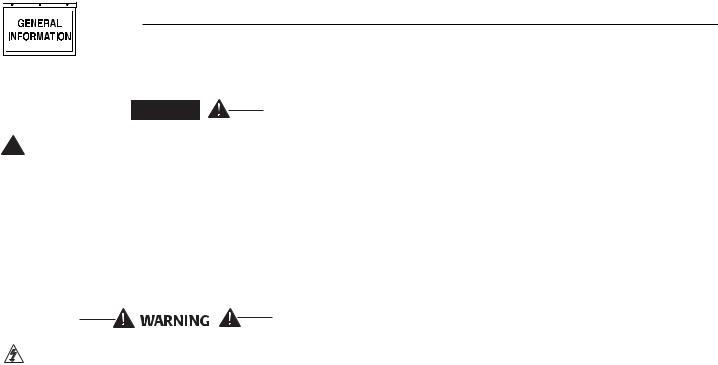
Section 1 — General Information
Guardian Air-cooled 7 kW, 12 kW and 15 kW Generators

 DANGER
DANGER
Only qualified electricians or contractors should
!attempt such installations, which must comply strictly with applicable codes, standards and regulations.
1.1UNPACKING/INSPECTION
After unpacking, carefully inspect the contents for damage.
•This standby generator set has been factory supplied with a weather protective enclosure that is intended for outdoor installation only.
If this generator is used to power electrical load circuits normally powered by a utility power source, it is required by code to install a transfer switch. The transfer switch must effectively isolate the electrical system from the utility distribution system when the generator is operating (NEC 700, 701 and 702). Failure to isolate an electrical system by such means will result in damage to the generator and also may result in injury or death to utility power workers due to backfeed of electrical energy.
If any loss or damage is noted at time of delivery, have the person(s) making the delivery note all damage on the freight bill or affix his or her signature under the consignor's memo of loss or damage.
If a loss or damage is noted after delivery, separate the damaged materials and contact the carrier for claim procedures.
“Concealed damage” is understood to mean damage to the contents of a package that is not in evidence at the time of delivery, but is discovered later.
1.2PROTECTION SYSTEMS
Unlike an automobile engine, the generator may have to run for long periods of time with no operator present to monitor engine conditions. For that reason, the engine is equipped with the following systems that protect it against potentially damaging conditions:
1. |
Low Oil Pressure Sensor |
3. |
Overcrank |
2. |
High Temperature Sensor |
4. |
Overspeed |
There are LED readouts on the control panel to indicate that one of these faults has occurred. There is also a “System Set” LED that is described below.
1.3SYSTEM SET LED
The “System Set” LED is lit when all of the following conditions are true:
1.The AUTO/OFF/MANUAL switch is set to the AUTO position.
2.The utility voltage being supplied to the unit is being sensed by the Control PCB. If the utility sense voltage is not connected to the unit or if it is below 168 volts AC, then the system set light will flash rapidly. This indicates that if the AUTO/OFF/MANUAL switch is placed in the Auto position , the generator will start.
3.The “Not In Auto” dip switch is set to the OFF position on the control board.
4.No alarms are present, for example, low oil pressure, high temperature, etc.
4
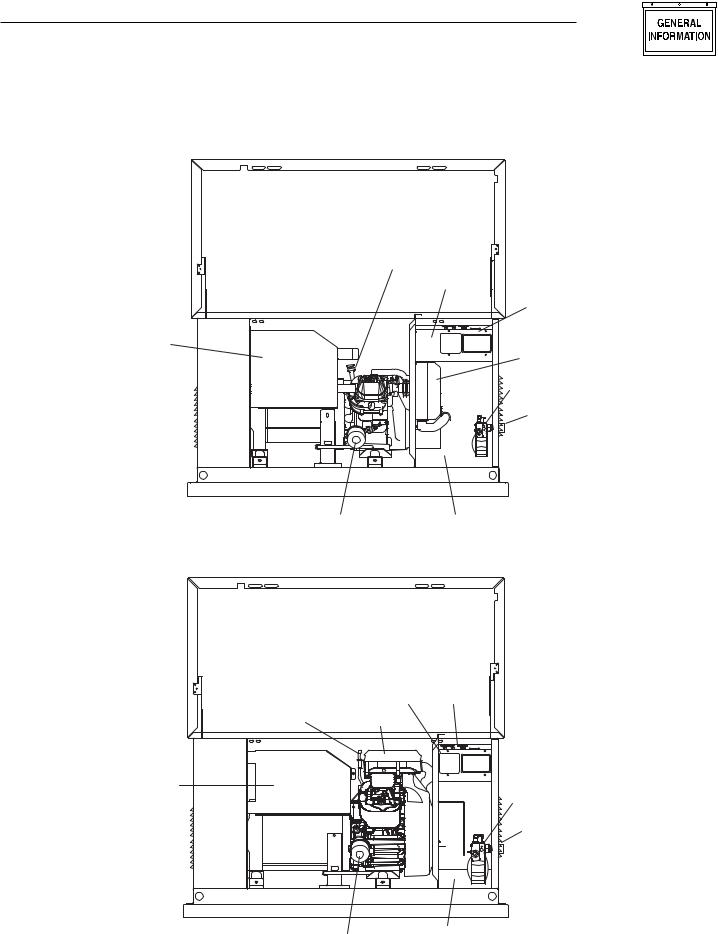
Section 1 — General Information
Guardian Air-cooled 7 kW, 12 kW and 15 kW Generators
1.4THE GENERATOR
Figure 1.1 – 7 kW, Single Cylinder GH-410 Engine
|
Oil Check/Fill |
|
Data Decal |
|
Control Panel |
Exhaust |
|
Enclosure |
Air Filter |
|
Fuel Regulator |
|
Fuel Inlet |
Oil Filter |
Battery Compartment |
Figure 1.2 – 12 kW/15 kW, V-twin GT-990 Engine
|
Data |
Control |
|
Decal |
Panel |
Oil Dipstick |
Air Filter |
|
Exhaust
Enclosure
Fuel Regulator
Fuel Inlet
Battery Compartment
Oil Filter
5

Section 1 — General Information
Guardian Air-cooled 7 kW, 12 kW and 15 kW Generators
1.5SPECIFICATIONS
1.5.1 GENERATOR
|
|
Model 04758 |
|
Model 04759 |
Model 04760 |
Rated Max. Continuous Power Capacity (Watts*) |
6,000 NG/7,000 LP |
|
12,000 NG/12,000 LP |
13,000 NG/15,000 LP† |
|
Rated Voltage |
120/240 |
|
120/240 |
120/240 |
|
Rated Max. Continuous Load Current (Amps) |
|
|
|
|
|
|
120 Volts + |
50.0 NG/58.3 LP |
|
100.0 NG/100.0 LP |
108.3 NG/125.0 LP |
|
240 Volts |
25.0 NG/29.2 LP |
|
50.0 NG/50.0 LP |
54.2 NG/62.5 LP |
Main Line Circuit Breaker |
30 Amp |
|
50 Amp |
70 Amp |
|
Phase |
1 |
|
1 |
1 |
|
Number of Rotor Poles |
2 |
|
2 |
2 |
|
Rated AC Frequency |
60 Hz |
|
60 Hz |
60 Hz |
|
Power Factor |
1 |
|
1 |
1 |
|
Recommended Air Filter |
Generac Part # C8127 |
Generac Part # C8127 |
Generac Part # C8127 |
||
Battery Requirement |
Group 26/26R |
|
Group 26/26R |
Group 26/26R |
|
|
|
12 Volts and |
|
12 Volts and |
12 Volts and |
|
|
350 Cold-cranking |
|
550 Cold-cranking |
550 Cold-cranking |
|
|
Amperes Minimum |
|
Amperes Minimum |
Amperes Minimum |
Weight |
452 Pounds |
|
470 Pounds |
487 Pounds |
|
Output Sound Level @ 23 ft (7m) at full load |
68 db (A) |
|
70.5db (A) |
71.5 db (A) |
|
Normal Operating Range |
|
-20°F (-28.8°C) to 104°F (40°C) |
|||
*Maximum wattage and current are subject to and limited by such factors as fuel Btu content, ambient temperature, altitude, engine power and condition, etc. Maximum power decreases about 3.5 percent for each 1,000 feet above sea level; and also will decrease about 1 percent for each 6° C (10° F) above 16° C (60° F).
+Total current in TWO separate curcuits. Current in each curcuit must not exceed the value stated for 240V.
1.5.2 ENGINE
|
Model 04758 |
Model 04759 |
Model 04760 |
Type of Engine |
GH-410 |
GT-990 |
GT-990 |
Number of Cylinders |
1 |
2 |
2 |
Rated Horsepower |
14.5 @ 3,600 rpm |
30 @ 3,600 rpm |
30 @ 3,600 rpm |
Displacement |
410cc |
992cc |
992cc |
Cylinder Block |
Aluminum w/Cast |
Aluminum w/Cast |
Aluminum w/Cast |
|
Iron Sleeve |
Iron Sleeve |
Iron Sleeve |
Valve Arrangement |
Overhead Valves |
Overhead Valves |
Overhead Valves |
Ignition System |
Solid-state w/Magneto |
Solid-state w/Magneto |
Solid-state w/Magneto |
Recommended Spark Plug |
RC12YC |
RC12YC |
RC12YC |
Spark Plug Gap |
0.76 mm (0.030 inch) |
0.508 mm (0.020 inch) |
0.508 mm (0.020 inch) |
Compression Ratio |
8.6:1 |
9.5:1 |
9.5:1 |
Starter |
12 Vdc |
12 Vdc |
12Vdc |
Oil Capacity Including Filter |
Approx. 1.5 Qts |
Approx. 1.7 Qts |
Approx. 1.7 Qts |
Recommended Oil Filter |
Generac Part # 70185 |
Generac Part # 70185 |
Generac Part # 70185 |
Recommended Air Filter |
Generac Part # 0C8127 |
Generac Part # 0C8127 |
Generac Part # 0C8127 |
Operating RPM |
3,600 |
3,600 |
3,600 |
6
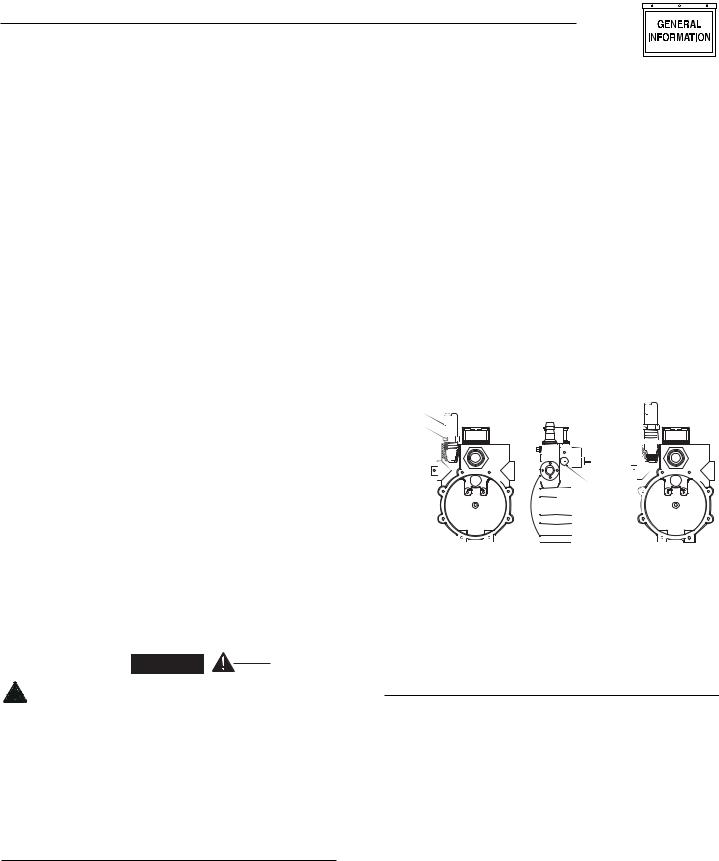
Section 1 — General Information
Guardian Air-cooled 7 kW, 12 kW and 15 kW Generators
1.6FUEL REQUIREMENTS
AND RECOMMENDATIONS
With LP gas, use only the vapor withdrawal system. This type of system uses the vapors formed above the liquid fuel in the storage tank.
The engine has been fitted with a fuel carburetion system that meets the specifications of the 1997 California Air Resources Board for tamper-proof dual fuel systems. The unit will run on natural gas or LP gas, but it has been factory set to run on natural gas. Should the primary fuel need to be changed to LP gas, the fuel system needs to be reconfigured. See Section 1.8 for instructions on reconfiguration of the fuel system.
Recommended fuels should have a Btu content of at least 1,000 BTU’s per cubic foot for natural gas; or at least 2,520 BTU’s per cubic foot for LP gas. Ask the fuel supplier for the BTU content of the fuel.
Fuel pressure for both natural gas and liquid propane set ups should be 11 inches to 14 inches of water column (0.6 psi) at all load ranges.
NOTE:
A separate gas line and regulator may be needed to assure proper gas pressure (11-14”) to the generator. Low gas pressure can cause hard starting and could affect engine durability.
1.7FUEL CONSUMPTION
|
Model # |
Nat. Gas (*) |
LP Vapor (**) |
|
||
|
|
1/2 Load |
Full Load |
1/2 Load |
Full Load |
|
|
04758 |
74 |
105 |
0.91/33 |
1.21/44.1 |
|
|
04759 |
114 |
185 |
1.34/48.9 |
2.17/79.0 |
|
|
04760 |
148.5 |
240 |
1.73/63.2 |
2.80/102.3 |
|
3.Disconnect wire #0 and wire #14 from the gas solenoid located on the top of the demand regulator.
4.Remove the demand regulator by rotating counterclockwise.
5.Remove the brass hose fitting from the outlet port of the demand regulator.
6.Remove the brass metering jet (loosen counterclockwise) from the housing port of the demand regulator located on the side of the regulator.
7.Install new LP metering jet (tighten clockwise) in the outlet port of the demand regulator.
8.Refit the brass hose fittings to the outlet port of the demand regulator.
9.Reverse procedure steps 1-4 to reinstall demand regulator.
10.Reverse the procedure to convert back to natural gas.
Figure 1.3 – Demand Regulator
|
FUEL HOSE |
FUEL HOSE |
BRASS HOSE |
BRASS HOSE |
FITTING |
|
|
FITTING |
|
|
OUTLET |
|
PORT |
FUEL JET 
REGULATOR
HOUSING PORT
NG FUEL SYSTEM |
LP FUEL SYSTEM |
NOTE:
*Natural gas is in cubic feet per hour.
**LP is in gallons per hour/cubic feet per hour.

 DANGER
DANGER
Gaseous fuels such as natural gas and liquid propane (LP) gas are highly explosive. Even the slightest spark can ignite such fuels and cause an explosion. No leakage of fuel is permitted. Natural gas, which is lighter than air, tends to collect in high areas. LP gas is heavier than air and tends to settle in low areas.
1.8RECONFIGURING THE FUEL SYSTEM
1.8.1 7 KW, 410CC
To reconfigure the fuel system from NG to LP, follow these steps:
1.Turn the main gas supply off.
2.Remove the carburetor fuel hose from the outlet port of the demand regulator (Figure 1.3).
The natural gas adjustment screw is preset during installation and should not need any further adjustment.
1.8.2 12KW AND 15KW, 990CC ENGINES
To reconfigure the fuel system from NG to LP, follow these steps:
NOTE:
The primary regulator for the propane supply is NOT INCLUDED with the generator. A fuel pressure of 11 to 14 inches of water column (0.6 psi) to the fuel inlet of the generator MUST BE SUPPLIED.
1.Turn OFF the main gas supply.
2.Remove the engine air in baffle located on the left hand side of the battery compartment. Two M6 screws are located on top of the baffle and two M6 screws are located on the inside of the baffle towards the back.
7
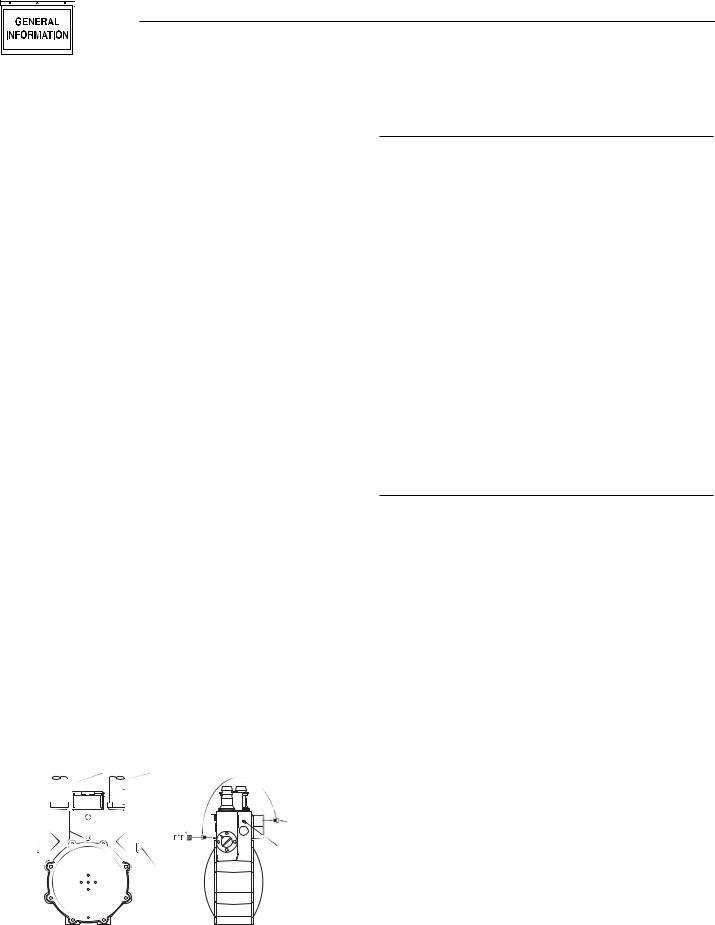
Section 1 — General Information
Guardian Air-cooled 7 kW, 12 kW and 15 kW Generators
3.Remove the small hose clamp and hose from the fuel regulator. It may be necessary to pry the hose off of the brass fitting using a screw driver to gently lift up the hose edge.
4.Remove the brass hose fitting screwed into the fuel regulator.
5.Locate and identify the brass idle jet. This will be located in the fuel regulator casting facing the front of the unit.
6.Remove the idle jet from its holding location.
7.Place the idle jet, thread side first, into the threaded hole originally occupied by the brass hose fitting.
8.Using a short No. 2 Phillips screw driver, thread the idle jet into the regulator casting. DO NOT OVER TIGHTEN.
9.Apply thread sealant to the threads of the hose fitting and replace it into the regulator body.
10.Re-attach the small hose and hose clamp and tighten as necessary.
11.Replace the engine air in baffle using the four M6 screws.
12.Identify both brass adjustment screws on the regulator.
NOTE:
One adjustment screw can be accessed from the front of the unit and the second can be accessed from the back of the unit enclosure by removing the plastic hole plug.
13.To adjust the system to run on LP fuel, turn the adjuster screw that can be accessed from inside the front of the unit, ¼ TURN CLOCKWISE. This should now set the system for maximum power and best performance.
14.It may be necessary to make minor adjustments to the preset adjustment screw settings to achieve maximum power. If experiencing problems with the unit producing maximum power, follow the procedure in Section 2.6 (Adjusting the Fuel Regulator).
Figure 1.4 - Demand Regulator
OUTLET PORTS
 FUEL HOSE
FUEL HOSE
BRASS HOSE
 FITTING
FITTING
IDLE CIRCUIT |
O |
|
BRASS HOSE |
SMALL |
PORT |
U |
|
||
T |
PRESSURE |
FITTING |
||
|
1 |
1/8 NPT |
|
FUEL JET |
|
TAP |
|
|
|
|
|
|
|
REGULATOR |
|
|
|
|
HOUSING PORT |
|
|
|
ADJUSTER |
|
|
|
|
SCREWS |
|
1.9LOCATION
1.9.1 GENERATOR
Install the generator set, in its protective enclosure, outdoors, where adequate cooling and ventilating air is always available. Consider these factors:
•Install the unit where air inlet and outlet openings will not become obstructed by leaves, grass, snow, etc. If prevailing winds will cause blowing or drifting, consider using a windbreak to protect the unit.
•Install the generator on high ground where water levels will not rise and endanger it.
•Allow sufficient room on all sides of the generator for maintenance and servicing. A good rule is to allow three feet of space on all sides.
•Where strong prevailing winds blow from one direction, face the generator air inlet openings to the prevailing winds.
•Install the generator as close as possible to the fuel supply, to reduce the length of piping.
•Install the generator as close as possible to the transfer switch. HOWEVER, REMEMBER THAT LAWS OR CODES MAY REGULATE THE DISTANCE.
1.9.2 TRANSFER SWITCH
1.9.2.1 7 kW, 12 kW and 15 kW Units
Transfer switches for use with these generators are sold separately and can be purchased from Generac Authorized Dealers.
•Install the transfer switch on a firm, sturdy supporting structure.
•To prevent switch distortion, level the switch if necessary. This can be done by placing washers between the switch enclosure and mounting surface.
•Never install the switch where water or any corrosive substance might drip onto the enclosure.
•Protect the switch at all times against excessive moisture, dust, dirt, lint, construction grit and corrosive vapors.
•Failure to utilize a Generac/Guardian transfer switch with this generator will void the warranty.
Transfer switches available for these generators are:
•Model 004678-0 — 100 Amp, 2 Pole, 250 Volt NEMA 1 (indoor rated) or
•Model 004635-0 — 200 Amp, 2 Pole, 250 Volt NEMA 3R (outdoor rated)
8
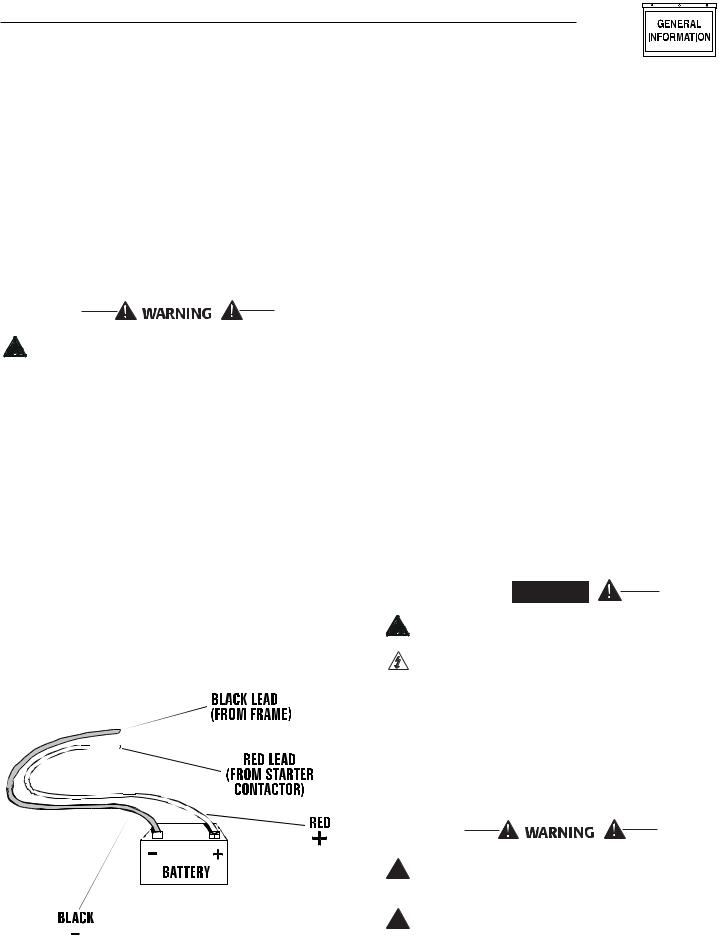
Section 1 — General Information
Guardian Air-cooled 7 kW, 12 kW and 15 kW Generators
1.10 BATTERY INSTALLATION |
NOTE: |
Fill the battery with the proper electrolyte fluid if necessary and have the battery fully charged before installing it.
Before installing and connecting the battery, complete the following steps:
1.Set the generator's AUTO/OFF/MANUAL switch to OFF.
2.Turn off utility power supply to the transfer switch.
3.Remove the 5 amp and 15 amp fuses from the generator control panel.
If the AUTO/OFF/MANUAL switch is not set to
its OFF position, the generator can crank and start as soon as the battery cables are connected. If the utility power supply is not turned off, sparking can occur at the battery posts and cause an explosion.
Battery cables were factory connected at the generator (Figure 1.5). Connect cables to battery posts as follows:
4.Connect the red battery cable (from starter contactor) to the battery post indicated by a positive, POS or (+).
5.Connect the black battery cable (from frame ground) to the battery post indicated by a negative, NEG or (—).
6.Replace the 5 amp and 15 amp fuses in the generator control panel.
NOTE:
Damage will result if battery connections are made in reverse.
Figure 1.5 – Battery Cable Connections
The generator is equipped with a battery trickle charger that is active when the unit is set up for automatic operation. With the battery installed and utility power source voltage available to the transfer switch, the battery receives a trickle charge while the engine is not running, to prevent self-discharge. The trickle charger is designed to help extend the life of the battery by maintaining the battery when the unit is not running. The trickle charge feature cannot be used to recharge a discharged battery.
1.11 THE BATTERY
Servicing of the battery is to be performed or supervised by personnel knowledgeable of batteries and the required precautions. Keep unauthorized personnel away from batteries.
When replacing the battery, use the following type of battery: Group 26/26R 12-volt battery with a rating of 350 cold-cranking amps minimum for 7 kW; 550 cold-cranking amps minimum for 12 and 15 kW at -18º C (0º F) minimum. When using a maintenancefree battery, it is not necessary to check the specific gravity or electrolyte level. Have these procedures performed at the intervals specified in the “Service Schedule.” A negative ground system is used. Battery connections are shown on the wiring diagrams. Make sure the battery is correctly connected and terminals are tight. Observe battery polarity when connecting the battery to the generator set.

 DANGER
DANGER
Do not dispose of the battery in a fire. The battery is capable of exploding.
A battery presents a risk of electrical shock and high short circuit current. The following precautions are to be observed when working on batteries:
•Remove watches, rings or other metal objects;
•Use tools with insulated handles;
•Wear rubber gloves and boots;
•Do not lay tools or metal parts on top of the battery; and
•Disconnect charging source prior to connecting or disconnecting battery terminals.
Do not open or mutilate the battery. Released
!electrolyte has been known to be harmful to the skin and eyes, and to be toxic.
The electrolyte is a dilute sulfuric acid that is
!harmful to the skin and eyes. It is electrically conductive and corrosive.
9
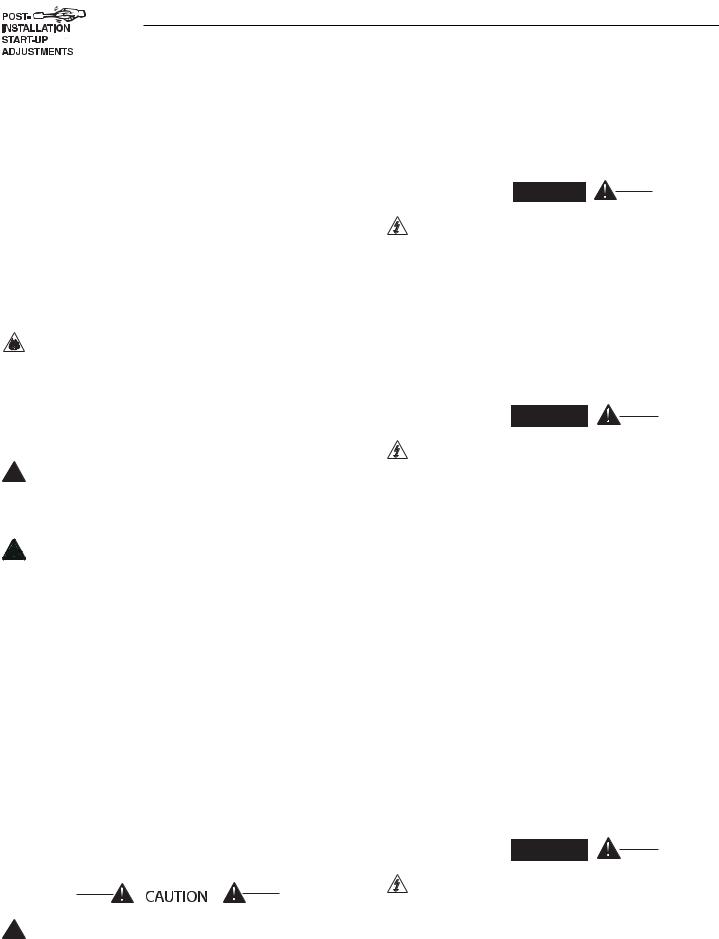
Section 2 — Post Installation Start-up and Adjustments
Guardian Air-cooled 7 kW, 12 kW and 15 kW Generators
The following procedures are to be observed:
•Wear full eye protection and protective clothing;
•Where electrolyte contacts the skin, wash it off immediately with water;
•Where electrolyte contacts the eyes, immediately flush thoroughly with water and seek medical attention; and
•Spilled electrolyte is to be washed down with an acid neutralizing agent. A common practice is to use a solution of 1 pound (500 grams) bicarbonate of soda to 1 gallon (4 liters) or water. The bicarbonate of soda solution is to be added until the evidence of reaction (foaming) has ceased. The resulting liquid is to be flushed with water and the area dried.
Lead-acid batteries present a risk of fire because they generate hydrogen gas. The following procedures are to be followed:
•DO NOT SMOKE when near the battery;
•DO NOT cause flame or spark in battery area; and
•Discharge static electricity from body before touching the battery by first touching a grounded metal surface.
Be sure the AUTO/OFF/MANUAL switch is set to ! the OFF position before connecting the battery cables. If the switch is set to AUTO or MANUAL,
the generator can crank and start as soon as the battery cables are connected.
Be sure the utility power supply is turned off, or sparking may occur at the battery posts as the cables are attached and cause an explosion.
2.1BEFORE INITIAL START-UP
Before starting, complete the following:
1.Set the generator’s main circuit breaker to its OFF (or open) position.
2.Set the generator's AUTO/OFF/MANUAL switch to the OFF position.
3.Turn OFF the utility power supply to the transfer switch using the means provided (such as the utility main line circuit breaker).
4.Check the engine crankcase oil level and, if necessary, fill to the dipstick FULL mark with the recommended oil. Do not fill above the FULL mark.
5.Check the fuel supply. Gaseous fuel lines must have been properly purged and leak tested in accordance with applicable fuel-gas codes. All fuel shutoff valves in the fuel supply lines must be open.
Never operate the engine with the oil level
!below the “Add” mark on the dipstick. Doing this could damage the engine.
2.2CHECK TRANSFER SWITCH
OPERATION
Refer to Section 3.5, of the owner’s manual for manual operation procedures.

 DANGER
DANGER
Do not attempt manual transfer switch operation until all power voltage supplies to the transfer switch have been positively turned off. Failure to turn off all power voltage supplies will result in extremely hazardous and possibly fatal electrical shock.
2.3ELECTRICAL CHECKS
Complete electrical checks as follows:
1.Turn on the utility power supply to the transfer switch using the means provided (such as a utility main line circuit breaker).

 DANGER
DANGER
The transfer switch is now electrically “hot.” Contact with “hot” parts will result in extremely hazardous and possibly fatal electrical shock. Proceed with caution.
2.Use an accurate AC voltmeter to check utility power source voltage across terminals N1 and N2. Nominal line-to-line voltage should be 240 volts AC.
3.Check utility power source voltage across terminals N1 and the transfer switch neutral lug; then across terminal N2 and neutral. Nominal line-to- neutral voltage should be 120 volts AC.
4.When certain that utility supply voltage is compatible with transfer switch and load circuit ratings, turn OFF the utility power supply to the transfer switch.
5.Set the generator's main circuit breaker to its OFF (or open) position. Initial tests will be conducted at no-load condition.
6.On the generator panel, set the AUTO/OFF/MANUAL switch to MANUAL. The engine should crank and start.
7.Let the engine warm up for about five minutes to allow internal temperatures to stabilize. Then, set the generator’s main circuit breaker to its ON (or closed) position.

 DANGER
DANGER
Proceed with caution! Generator power voltage is now supplied to the transfer switch. Contact with live transfer switch parts will result in dangerous and possibly fatal electrical shock.
10

Section 2 — Post Installation Start-up and Adjustments
Guardian Air-cooled 7 kW, 12 kW and 15 kW Generators
8.Connect an accurate AC voltmeter and a frequency meter across transfer switch terminal lugs E1 and E2. Voltage should be 242-252 volts; frequency should read about 61-63 Hertz.
9.Connect the AC voltmeter test leads across terminal lug E1 and neutral; then across E2 and neutral. In both cases, voltage reading should be 121126 volts AC.
10.Set the generator’s main circuit breaker to its OFF (or open) position. Let the engine run at noload for a few minutes to stabilize internal engine generator temperatures.
11.Set the generator's AUTO/OFF/MANUAL switch to OFF. The engine should shut down.
NOTE:
It is important not to proceed until certain that generator AC voltage and frequency are correct and within the stated limits. Generally, if both AC frequency and voltage are high or low, the engine governor requires adjustment. If frequency is correct, but voltage is high or low, the generator’s voltage regulator requires adjustment.
2.4GENERATOR TESTS UNDER LOAD
To test the generator set with electrical loads applied, proceed as follows:
1.Set generator’s main circuit breaker to its OFF (or open) position.
2.Set the generator's AUTO/OFF/MANUAL switch to OFF.
3.Turn OFF the utility power supply to the transfer switch, using the means provided (such as a utility main line circuit breaker).
Do not attempt manual transfer switch operation until all power voltage supplies to the transfer switch have been positively turned off. Failure to turn off all power voltage supplies will result in extremely hazardous and possibly fatal electrical shock.
4.Manually set the transfer switch to the STANDBY position, i.e., load terminals connected to the generator's E1/E2 terminals. The transfer switch operating lever should be down.
5.Set the generator's AUTO/OFF/MANUAL switch to MANUAL. The engine should crank and start immediately.
6.Let the engine stabilize and warm up for a few minutes.
7.Set the generator’s main circuit breaker to its ON (or closed) position. Loads are now powered by the standby generator.
8.Turn ON electrical loads. Apply an electrical load equal to the full rated wattage/amperage capacity of the installed generator.
9.Connect an accurate AC voltmeter and a frequency meter across terminal lugs E1 and E2. Voltage should be greater than 230 volts; frequency should be greater than 58 Hertz.
10.Let the generator run at full rated load for 20-30 minutes. Listen for unusual noises, vibration or other indications of abnormal operation. Check for oil leaks, evidence of overheating, etc.
11.When testing under load is complete, turn OFF electrical loads.
12.Set the generator's main circuit breakers to their OFF (or open) positions.
13.Let the engine run at no-load for a few minutes.
14.Set the AUTO/OFF/MANUAL switch to OFF. The engine should shut down.
2.5CHECKING AUTOMATIC
OPERATION
To check the system for proper automatic operation, proceed as follows:
1.Set the generator’s main circuit breaker to it’s OFF (or open) position.
2.Check that the AUTO/OFF/MANUAL switch is set to OFF.
3.Turn OFF the utility power supply to the transfer switch using the means provided (such as a utility main line circuit breaker).
4.Manually set the transfer switch to the UTILITY position, i.e., load terminals connected to the utility power source side.
5.Turn ON the utility power supply to the transfer switch, using the means provided (such as a utility main line circuit breaker).
6.Set the AUTO/OFF/MANUAL switch to AUTO. Then set the generator’s main circuit breaker to its ON (or closed) position. The system is now ready for automatic operation.
7.Turn OFF the utility power supply to the transfer switch.
With the AUTO/OFF/MANUAL switch at AUTO, the engine should crank and start when the utility source power is turned OFF. After starting, the transfer switch should connect load circuits to the standby side. Let the system go through its entire automatic sequence of operation.
With the generator running and loads powered by generator AC output, turn ON the utility power supply to the transfer switch. The following should occur:
•After about six seconds, the switch should transfer loads back to the utility power source.
•About one minute after retransfer, the engine should shut down.
11
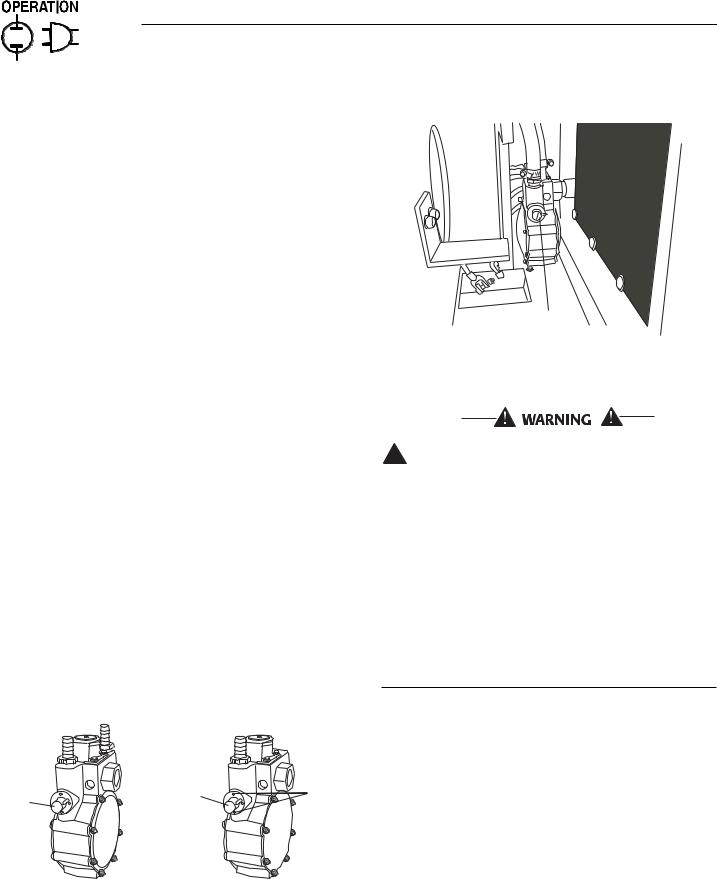
Section 3 — Operation
Guardian Air-cooled 7 kW, 12 kW and 15 kW Generators
2.6ADJUSTING THE REGULATOR
(NATURAL GAS ONLY)
Although the generator has been factory set to provide maximum power, it may be necessary in some areas to adjust this setting. Because natural gas has different BTU or power content across the country the engine may not perform as designed.
If experiencing engine problems at high or full load conditions follow these steps. It will require a frequency meter to perform this procedure.
1.Turn off utility power to the main distribution panel in the house. This can be done by switching the service main breaker to the off or open position.
2.Allow the generator to start before loading the generator. Confirm the no-load frequency with the roof open and door off is set at 63-63.5 Hz. Transfer load to emergency circuits.
3.Turn on appliances, lights, pumps, etc., that are on the emergency circuits in an attempt to fully load the generator. Be cautious not to overload the generator. Use the following chart as a guide:
Figure 2.2 — Placement of Regulator
Adjustment Screw
7.Turn utility power to the main distribution panel back on. This can be done by switching the service main breaker to the on or closed position. Allow the generator to shut down.
|
Unit |
120 Volts |
240 Volts |
|
|
7 kW |
50.0 amps |
25.0 amps |
|
|
12 kW |
100.0 amps |
50.0 amps |
|
|
15 kW |
108.3 amps |
54.2 amps |
|
|
|
|
|
|
4.When full load has been achieved. Connect a frequency meter to the output lugs of the generator’s main line circuit breaker.
5.The fuel regulator is fitted with one (7 kW), or two (12 & 15 kW) adjustment screws. While watching the frequency meter, slowly turn the adjustment screw clockwise or counterclockwise one at a time until highest frequency is read on the meter. Only limited adjustment is available between the set pins. Under no circumstances should any of the pins be removed (Figures 2.1 and 2.2).
Figure 2.1 — Dual Fuel Regulators
12, 13, and 15 kW |
6 and 7 kW |
990 |
410 |
Adjustment |
Adjustment |
Set |
|
Screw |
|||
Pins |
|||
Screw |
|||
(One Side |
|||
|
|||
(Both sides) |
|
||
Only) |
|
||
|
|
6.When the highest frequency is reached maximum power has been set. Then turn both adjustment screws 1/4 turn counterclockwise. Regulator is now set.
12
Do not make any unnecessary adjustments.
!Factory settings are correct for most applications. However, when making adjustments, be careful to avoid overspeeding the engine.
If this procedure or equipment are not available, locate the nearest Generac Guardian Dealer and they can perform the adjustments.
NOTE:
A service fee may be charged for this adjustment.
2.7ENGINE GOVERNOR ADJUSTMENT
If both AC frequency and voltage are correspondingly high or low, adjust the engine governor as follows:
2.7.1 7 KW UNITS
1.Loosen the governor clamp bolt (Figure 2.3).
2.Hold the governor lever at its wide open throttle position, and rotate the governor shaft clockwise as far as it will go. Then, tighten the governor lever clamp bolt to 70 inch-pounds (8 N-m).
3.Start the generator; let it stabilize and warm up at no-load.
4.Connect a frequency meter across the generators AC output leads.
5.Turn the speed adjust nut to obtain a frequency reading of 63 Hz.
6.When frequency is correct at no load, check the AC voltage reading. If voltage is incorrect, the voltage regulator may require adjustment.
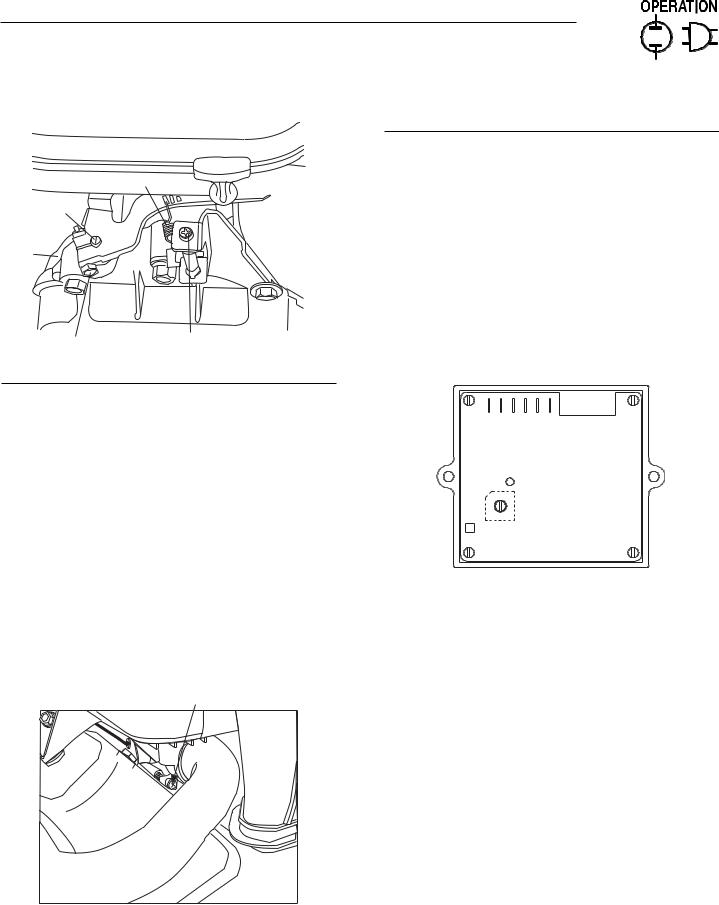
Section 3 — Operation
Guardian Air-cooled 7 kW, 12 kW and 15 kW Generators
Figure 2.3 — Engine Governor Adjustment
Idle Spring
Governor
Shaft
(Rotate Clockwise)
2.7.3 ADDITIONAL CORROSION PROTECTION
Periodically spray all engine linkage parts and brackets with corrosion inhibiting spray such as WD-40 or a comparable product.
2.8VOLTAGE REGULATOR
ADJUSTMENT
With the frequency between 62-63.5 Hertz, slowly turn the slotted potentiometer (Figure 2.5) until line voltage reads 244-252 volts.
NOTE:
Remove the access panel on top of the control panel to adjust the voltage regulator.
Governor Clamp Bolt |
No Load Idle |
|
Adjustment Screw |
||
|
2.7.2 12 KW AND 15 KW UNITS
1.Loosen governor clamp bolt (See Figure 2.3).
2.Completely remove the idle spring.
3.With governor arm at wide open throttle position, rotate governor shaft fully clockwise. Tighten clamp bolt to 84 inch-pounds.
4.Start unit and apply full load. Use full load speed adjust screw (Figure 2.4) to adjust frequency to 58 Hz.
5.Remove load, stop engine, loosen the idle adjust screw and reconnect the idle spring.
6.Using a hand, push the governor arm to the closed throttle position. Make sure the idle spring does not stretch at all.
7.Restart the unit.
8.Slowly turn the idle adjust screw to adjust the noload idle frequency to 63-63.5 Hz.
9.The governor is now set.
Figure 2.4 — Full Load Speed Adjust Screw
Full Load Speed Adjust Screw
Figure 2.5 – Voltage Adjustment Potentiometer
NOTE:
The voltage regulator is housed above the generator's control panel. The regulator maintains a voltage in direct proportion to frequency. For example, at 62 Hertz, line-to-neutral voltage will be 124 volts.
3.1BREAK-IN PROCEDURE
Once the unit has been installed, with utility power connected to the transfer switch, and all electrical checks have been made, it is strongly recommended that the following “Break-in Procedure” be completed to ensure correct generator operation in the future.
1.Set the generator’s AUTO/OFF/MANUAL switch to AUTO.
2.Turn OFF the utility power supply to the transfer switch using the means provided (such as a utility main line circuit breaker).
3.The unit will start, and the transfer switch will transfer to standby.
4.Run the unit for one hour at 25 percent load.
5.Run the unit for one hour at 50 percent load.
6.Run the unit for one hour at 75 percent load.
7.Run the unit for one hour at 100 percent load.
13
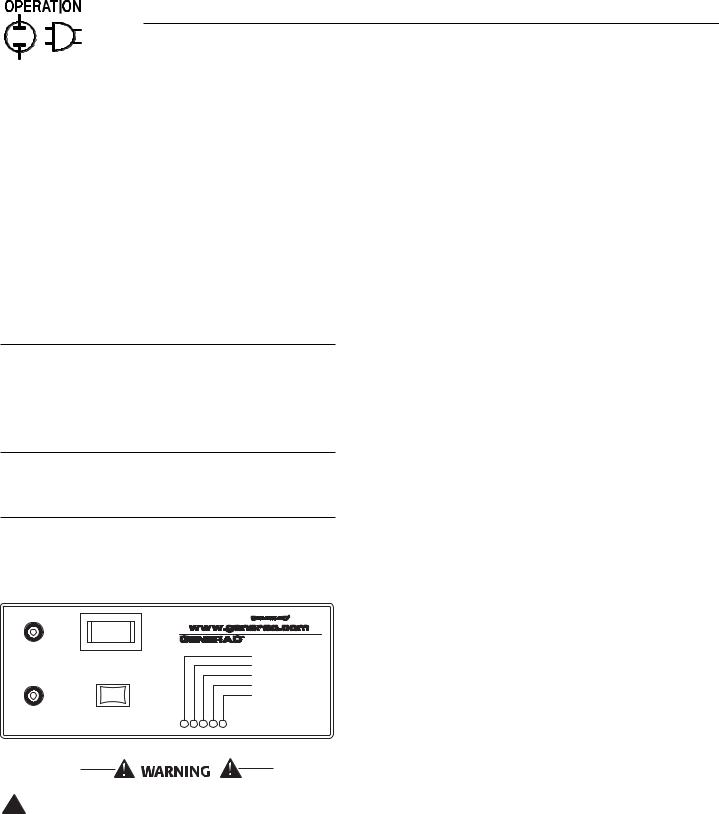
Section 3 — Operation
Guardian Air-cooled 7 kW, 12 kW and 15 kW Generators
8.Turn ON the utility power supply to the transfer switch, which will allow the transfer switch to transfer back to utility power. The unit will continue to run for one minute and then shut down.
9.Allow the unit to cool.
10.Drain the oil and remove the oil filter. Replace the oil filter according to Section 4.4, “Changing the Oil Filter”. Replace the oil with synthetic oil as recommended in Section 4.3, “Changing the Engine Oil”.
11.The generator is now ready for service.
3.2USING THE AUTO/OFF/MANUAL SWITCH (FIGURE 3.1)
3.2.1 “AUTO” POSITION
Selecting this switch position activates fully automatic system operation. It also permits starting and exercising the engine every seven days with the setting of the exercise timer (see Section 3.6). This position also is used for remote starting, when it is set up.
3.2.2 “OFF” POSITION
This switch position shuts down the engine. This position also prevents automatic operation.
3.2.3 “MANUAL” POSITION
Set the switch to MANUAL to crank and start the engine. Transfer to standby power will not occur unless there is a utility failure.
Figure 3.1 – Generator Control Panel
FUSE
L o c a t e y o u r n e a r e s t |
d e a le r a t : |
POWER SYSTEMS, INC. |
|
5A |
SYSTEM SET |
AUTO OFF MAN. |
|
LOW OIL
3.3AUTOMATIC TRANSFER
OPERATION
To select automatic operation, do the following:
1.Make sure the transfer switch main contacts are set to their “Utility” position, i.e., loads connected to the utility power source (Figure 3.2).
2.Be sure that normal utility power source voltage is available to transfer switch terminal lugs N1 and N2.
3.Set the generator’s AUTO/OFF/MANUAL switch to AUTO.
4.Set the generator’s main circuit breaker to its ON (or closed) position.
With the preceding steps complete, the generator will start automatically when utility source voltage drops below a preset level. After the unit starts, loads are transferred to the standby power source. Refer to Section 3.4, “Sequence of Automatic Operation.”
3.4SEQUENCE OF AUTOMATIC
OPERATION
The generator’s control panel houses a control logic circuit board. This board constantly monitors utility power source voltage. Should that voltage drop below a preset level, circuit board action will signal the engine to crank and start. After the engine starts, the circuit board signals the transfer switch to activate and connect load circuits to the standby power supply (load terminal lugs T1/T2 connect to terminal lugs E1/E2).
Upon restoration of utility source voltage above a preset level, generator circuit board action signals the transfer switch to transfer loads back to that power supply. After retransfer, the engine is signalled to shut down.
The actual sequence of operation is controlled by sensors and timers on a control logic circuit board, as follows:
FUSE |
|
HIGH TEMP. |
|
|
|
OVER SPEED |
|
|
|
OVER CRANK |
|
15A |
SET |
F L A S H IN G G R E E N L E D = |
|
|
EXERCISE |
N O U T IL IT Y S E N S E |
|
|
4 F L A S H IN G R E D |
L E D S = |
|
|
TIME |
E X E R C IS E R |
N O T S E T |
With the switch set to AUTO, the engine may
!crank and start at any time without warning. Such automatic starting normally occurs when utility power source voltage drops below a preset level or during the normal exercise cycle. To prevent possible injury that might be caused by such sudden starts, always set the switch to OFF and remove both fuses before working on or around the generator or transfer switch. Then, place a “Do Not Operate” tag on the generator panel and on the transfer switch.
A.Utility Voltage Dropout Sensor
•This sensor monitors utility source voltage.
•If utility source voltage drops below about 70 percent of the nominal supply voltage, the sensor energizes a 15-second timer.
•Once the timer has expired, the engine will crank and start.
B.Engine Warm-up Time Delay
•This mechanism lets the engine warm up for about 10 seconds before the load is transferred to a standby source.
C.Standby Voltage Sensor
•This sensor monitors generator AC output voltage. When the voltage has reached 50 percent of the nominal rated voltage, transfer to standby can occur.
14
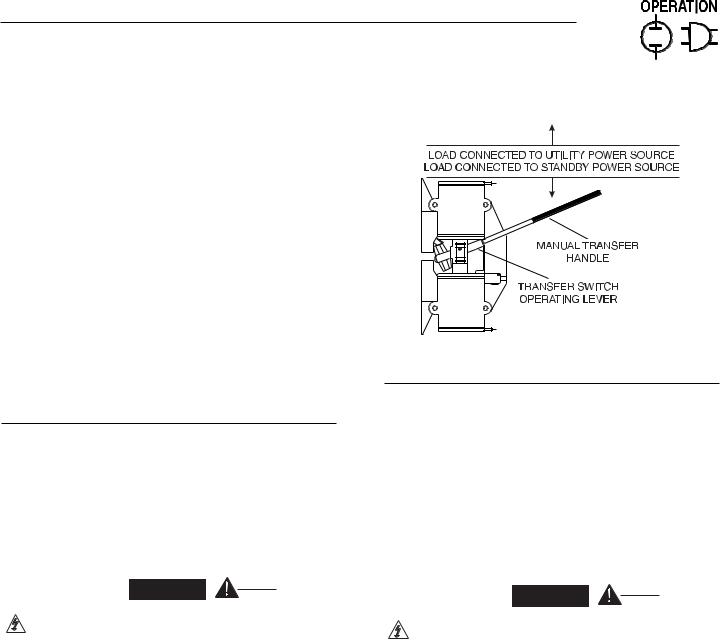
Section 3 — Operation
Guardian Air-cooled 7 kW, 12 kW and 15 kW Generators
D.Utility Voltage Pickup Sensor |
Figure 3.2 – Manual Transfer Switch Operation |
• This sensor monitors utility power supply volt- |
|
age. When that voltage is restored to above 70 |
|
percent of the nominal source voltage, a retrans- |
|
fer time delay starts timing. |
|
E.Retransfer Time Delay |
|
• This timer runs for about 15 seconds. |
|
• At end of a 15-second delay, circuit board action |
|
de-energizes the transfer relay in the transfer |
|
switch. |
|
• Retransfer to utility power source then occurs. |
|
F. Engine Cool-down Timer |
|
• When the load is transferred back to utility power |
|
source, the engine cool-down timer starts timing. |
|
• The timer will run for about one minute, and the |
|
generator will then shut down. |
|
3.5MANUAL TRANSFER OPERATION
3.5.1 TRANSFER TO GENERATOR POWER SOURCE
To start the generator and activate the transfer switch manually, proceed as follows:
1.Set the generator’s main circuit breaker to its OFF (or open) position.
2.Set the generator’s AUTO/OFF/MANUAL switch to OFF.
3.Turn OFF the utility power supply to the transfer switch using the means provided (such as a utility main line circuit breaker).

 DANGER
DANGER
Do not attempt to activate the transfer switch manually until all power voltage supplies to the switch have been positively turned off. Failure to turn off all power voltage supplies may result in extremely hazardous and possibly fatal electrical shock.
4.Use the manual transfer handle inside the transfer switch to move the main contacts to their “Standby” position, i.e., loads connected to the standby power source (Figure 3.2).
5.To crank and start the engine, set the AUTO/OFF/ MANUAL switch to MANUAL.
6.Let the engine stabilize and warm up for a few minutes.
7.Set the generator’s main circuit breaker to its ON (or closed) position. The standby power source now powers the loads.
3.5.2 TRANSFER BACK TO UTILITY POWER SOURCE
When utility power has been restored, transfer back to that source and shut down the generator. This can be accomplished as follows:
1.Set the generator’s main circuit breaker to its OFF (or open) position.
2.Let the engine run for a minute or two at no-load to stabilize the internal temperatures.
3.Set the generator’s AUTO/OFF/MANUAL switch to its OFF (or open) position. The engine should shut down.
4.Check that utility power supply to the transfer switch is turned OFF.

 DANGER
DANGER
Do not attempt to activate the transfer switch manually until all power voltage supplies
to the switch have been positively turned off. Failure to turn off all power voltage supplies may result in extremely hazardous and possibly fatal electrical shock.
5.Use the manual transfer handle inside the transfer switch to move the main contacts back to their “Utility” position, i.e., loads connected to the utility power source (Figure 3.2).
6.Turn ON the utility power supply to the transfer switch using the means provided.
7.Set the system to automatic operation as outlined in “Automatic Transfer Operation,” Section 3.3.
15
